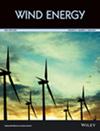A novel collaborative control algorithm for maximum power point tracking of wind energy hydraulic conversion system
IF 3.3
3区 工程技术
Q3 ENERGY & FUELS
引用次数: 0
Abstract
Abstract Wind has been admitted as one of the most promising renewable energy resources in multinational regionalization policies. However, the energy conversion and utilization are challenging due to the technique reliability and cost issues. Hydraulic wind turbine (HWT) may solve the above problems. HWT is taken as a research object, and the maximum power point tracking (MPPT) control strategy is proposed collaborating with active disturbance rejection control (ADRC) and linear quadratic regulator (LQR) control methods, to solve multiplicative nonlinearity problems in the plant models and the influence of external disturbance on control performance in the MPPT control process. A nonlinear simulation model is built to explain the main findings from the experiments and obtain a better understanding of the effect of time‐varying system parameters and random fluctuation in wind speed. The collaborative control algorithm is experimentally verified on a 24‐kW HWT semi‐physical test platform that results in a promising energy conversion rate, plus the hydraulic parameters can satisfy the demand, accordingly. Ultimately, the potential challenges of implementing this technique in a smart wind energy conversion system are discussed to give a further design guidance, either theoretically or practically.一种新的风能液压转换系统最大功率点跟踪协同控制算法
风能已被多国区域化政策公认为最具发展前景的可再生能源之一。然而,由于技术可靠性和成本问题,能量的转换和利用具有挑战性。水力风力发电机(HWT)可以解决上述问题。以HWT为研究对象,结合自抗扰控制(ADRC)和线性二次型调节器(LQR)控制方法,提出了最大功率点跟踪(MPPT)控制策略,解决了最大功率点跟踪控制过程中存在的乘性非线性问题和外部干扰对控制性能的影响。建立了一个非线性仿真模型来解释实验的主要结果,并更好地理解时变系统参数和风速随机波动的影响。在24 kW HWT半物理测试平台上对该协同控制算法进行了实验验证,结果表明,该协同控制算法具有良好的能量转化率,且水力参数能够满足要求。最后,讨论了在智能风能转换系统中实施该技术的潜在挑战,以在理论上或实践上提供进一步的设计指导。
本文章由计算机程序翻译,如有差异,请以英文原文为准。
求助全文
约1分钟内获得全文
求助全文
来源期刊

Wind Energy
工程技术-工程:机械
CiteScore
9.60
自引率
7.30%
发文量
0
审稿时长
6 months
期刊介绍:
Wind Energy offers a major forum for the reporting of advances in this rapidly developing technology with the goal of realising the world-wide potential to harness clean energy from land-based and offshore wind. The journal aims to reach all those with an interest in this field from academic research, industrial development through to applications, including individual wind turbines and components, wind farms and integration of wind power plants. Contributions across the spectrum of scientific and engineering disciplines concerned with the advancement of wind power capture, conversion, integration and utilisation technologies are essential features of the journal.
 求助内容:
求助内容: 应助结果提醒方式:
应助结果提醒方式:


